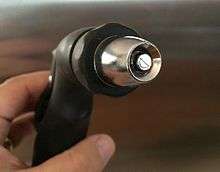Plug nozzle
The plug nozzle is a type of nozzle which includes a centerbody or plug around which the working fluid flows. Plug nozzles have applications in aircraft, rockets, and numerous other fluid flows.
Hoses

Common garden hose trigger nozzles are a simple example of the plug nozzle and its method of operation. In this example the nozzle consists of a conical or bell shaped opening with a plug on a movable rod positioned in front of the nozzle. The plug looks similar to a poppet valve. The stem of the valve runs back through the body of the nozzle body to a "trigger", normally a long lever running down the back of the nozzle assembly. A spring keeps the valve pressed against the opening under normal use, thereby providing a failsafe cut-off that stops the flow of water when the nozzle is dropped.
When water is supplied to the hose, it flows through the nozzle body to the opening, where it would normally flow straight forward in a stream. Just after leaving the opening it encounters the plug, which deflects the water sideways through an angle. After travelling a short distance the water encounters the outside of the nozzle opening, which deflects it forward again. This two-step process causes the water to be ejected in a ring-shaped pattern, which causes less water to strike any one location, and thereby reduces erosion while also making it easier to water larger areas.
The shaping of the plug and the nozzle opening allows the angle of the ring to be adjusted. Normally this is shaped so that when the plug is pulled back toward the opening it both partially cuts off the water flow, as well as causing it to spread out to the widest possible angle. This can be used for "misting" plants. When the trigger is pushed down further, the plug moves away from the opening, causing less blockage and disruption of the flow, ultimately allowing the water to form back into a stream.
In rockets
Plug nozzles belong to a class of altitude compensating nozzles much like the aerospike which, unlike traditional designs, maintains its efficiency at a wide range of altitudes.[1]
Similar to the garden hose example, plug nozzles use a shaped rocket nozzle with a poppet-shaped plug to allow the pattern of the rocket exhaust to be changed. This is used to adjust for changes in altitude; at lower altitudes the plug is pulled back to cause the exhaust to spread out, while at higher altitudes the lower air pressure will cause this to happen naturally. An alternative construction for the same basic concept is to use two nozzles, one inside the other, and adjust the distance between them. This pattern has the advantage of better control over the exhaust and simpler cooling arrangements.
Confusingly, the term "plug nozzle" may also be used to refer to an entirely different class of engine nozzles, the aerospikes. In theory the aerospike should look roughly like a lance. with a wide base and long tapering forebody. However, the "spike" portion can be cut off with only minor effects on performance, leaving just the base section. This looks very similar to a common drain plug or bung, and leads to widespread use of the term "plug nozzle" for this design as well.
In aircraft

Plug nozzles are used in aircraft typically with jet engines — the Junkers Jumo 004's Zwiebel (onion) movable restrictive body being a pioneering example, providing a form of variable geometry with its exhaust — both because of the annular shape of the turbine exhaust and for their altitude compensating characteristics. For high speed aircraft, translating the plug or external cowl provides a means of area control with relatively simple actuation. Plug nozzles have been shown to provide noise reduction compared to traditional convergent-divergent nozzles.[2] Weight and cooling are typical concerns with aircraft plug nozzles.[3]
See also
Further reading
- Aerospike Engine, Jeff Scott, Fall 1999. This paper gives an extensive review of the various altitude compensating nozzle designs.
References
- ↑ O'Leary, R.A.; Beck, J. E. (Spring 1992). "Nozzle Design". Threshold (Pratt & Whitney Rocketdyne).
- ↑ Journal of Sound and Vibration Volume 206, Issue 2, 18 September 1997, Pages 169-194.
- ↑ Stitt, Leonard E. (May 1990). "Exhaust Nozzles for Propulsion Systems With Emphasis on Supersonic Cruise Aircraft" (pdf). Reference Publication 1235 (NASA). Retrieved 14 July 2012. (42.1 Mb)